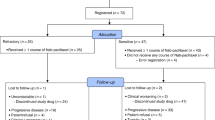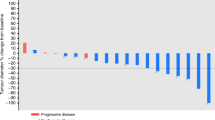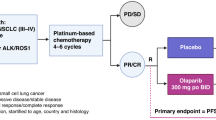Abstract
Proliferation of drug resistant tumour following chemotherapy is the principal cause of treatment failure in small cell lung cancer (SCLC). Verapamil has been shown to partially restore drug sensitivity in tumour cells rendered resistant in vitro. The results of the first large-scale randomised study of a resistance modifying drug given in conjunction with chemotherapy in cancer patients are reported. Two hundred and twenty-six patients have been entered. All patients received four cycles of cyclophosphamide (750 mg m-2), doxorubicin (40 mg m-2) and vincristine (1.4 mg m-2) on Day 1 and etoposide (75 mg m-2) on Days 1, 2 and 3, repeated at 21 day intervals. Those patients randomised to the verapamil arm received oral verapamil 120 mg qid for 5 days with each course of chemotherapy. Similar numbers of cycles of protocol treatment were given in both arms with over 75% of patients completing all four cycles. There were no significant differences in general toxicities between the two arms, except for more severe alopecia in the verapamil treatment group (P = 0.045). There was no significant difference in cardiovascular or haematological toxicity, although the median nadir white cell count after Cycle 1 chemotherapy was lower in the verapamil arm (P = 0.065) and there were significantly more dose reductions after Cycle 1 in the verapamil arm (P = 0.031). No statistically significant differences in response (P = 0.582) or survival (P = 0.290) data were seen. The absence of a significant improvement in response or survival using verapamil may relate to the low blood levels of verapamil seen in the clinic (0.8 microM), in contrast to those known to be maximally active in vitro (> 6 microM) or to the presence of other cellular mechanisms by which drug resistance develops.
This is a preview of subscription content, access via your institution
Access options
Subscribe to this journal
Receive 24 print issues and online access
$259.00 per year
only $10.79 per issue
Buy this article
- Purchase on Springer Link
- Instant access to full article PDF
Prices may be subject to local taxes which are calculated during checkout
Similar content being viewed by others
Author information
Authors and Affiliations
Consortia
Rights and permissions
About this article
Cite this article
Milroy, R., on behalf of the West of Scotland Lung Cancer Research Group, and the Aberdeen Oncology Group. A randomised clinical study of verapamil in addition to combination chemotherapy in small cell lung cancer. Br J Cancer 68, 813–818 (1993). https://doi.org/10.1038/bjc.1993.433
Issue Date:
DOI: https://doi.org/10.1038/bjc.1993.433
This article is cited by
-
Polymers in the co-delivery of siRNA and anticancer drugs to treat multidrug-resistant tumors
Journal of Pharmaceutical Investigation (2017)
-
Reversal of ATP-binding cassette drug transporter activity to modulate chemoresistance: why has it failed to provide clinical benefit?
Cancer and Metastasis Reviews (2013)
-
Drug penetration in solid tumours
Nature Reviews Cancer (2006)
-
Targeting multidrug resistance in cancer
Nature Reviews Drug Discovery (2006)



